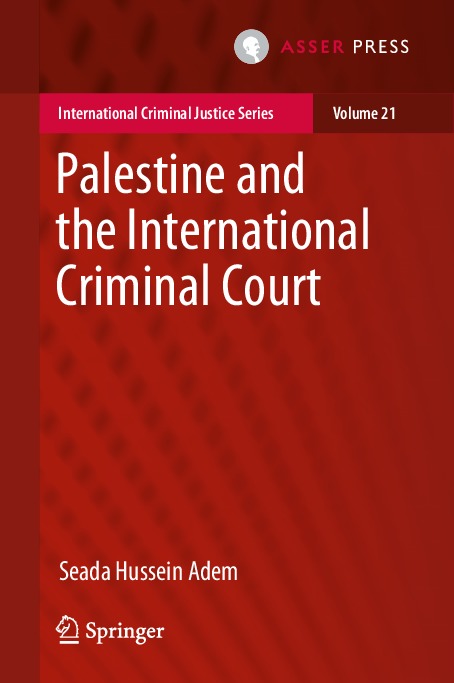File #2775: "2019_Book_PalestineAndTheInternationalCr.pdf"
Testo
1|Acknowledgements|6
1|Contents|8
1|Abbreviations and Acronyms|12
1|1 Introduction and Overview|14
2|Abstract|14
2|1.1 Background|14
2|1.2 Objectives|17
2|1.3 Literature Survey|18
2|1.4 Limitation|20
2|1.5 Outline|21
2|References|22
1|2 Historical and Political Background of the Israeli-Palestinian Conflict|24
2|Abstract|24
2|2.1 Introductory Remarks|25
2|2.2 The Origins of the Israeli-Palestinian Conflict|25
3|2.2.1 Pre-Israel Palestine|26
3|2.2.2 Jewish Persecution and Zionism|27
3|2.2.3 The British, the Jews and the Palestinians|29
3|2.2.4 The Partition|32
2|2.3 Occupation and Resistance|34
3|2.3.1 The Arab-Israeli Wars|34
3|2.3.2 The Resistance: Guerrillas and Stones|37
2|2.4 The Occupied Palestinian Territories|41
3|2.4.1 Gaza|41
3|2.4.2 The West Bank|44
3|2.4.3 East Jerusalem|46
2|2.5 Military Operations and the UN Missions|48
3|2.5.1 Operation Cast Lead|48
3|2.5.2 Operation Protective Edge|50
2|2.6 Peace Negotiations|51
2|2.7 Chapter Summary|53
2|References|54
1|3 The 2009 Palestinian Ad hoc Declaration|62
2|Abstract|62
2|3.1 Introductory Remarks|63
2|3.2 The Legal Regime of Ad hoc Declarations|63
2|3.3 Decision of the Prosecutor on the 2009 Palestinian Declaration|67
2|3.4 Determination of Statehood for the Purpose of the ICC Jurisdiction|68
3|3.4.1 ‘Kompetenz-Kompetenz’|70
3|3.4.2 Possible Avenues to Determine the Statehood Issue|71
2|3.5 The Palestine Statehood Issue|75
3|3.5.1 The Statehood of Palestine: General Considerations|75
4|3.5.1.1 Palestine’s Declaration of Statehood|75
4|3.5.1.2 The Montevideo Convention|77
4|3.5.1.3 Theories of State Recognition|80
4|3.5.1.4 Palestine as an Occupied Territory|82
4|3.5.1.5 Conclusion on the Abstract Statehood of Palestine|82
3|3.5.2 The Functional Approach: Statehood for the Purposes of Ad hoc Declarations|83
2|3.6 Subsequent Developments|88
2|3.7 Chapter Summary|88
2|References|89
1|4 Pre-Investigation Considerations|92
2|Abstract|92
2|4.1 Introductory Remarks|93
2|4.2 Preliminary Examination: An Overview|94
2|4.3 Jurisdiction|97
3|4.3.1 Ratione temporis|97
3|4.3.2 Ratione materiae|101
3|4.3.3 Ratione loci or personae|103
2|4.4 Admissibility|104
3|4.4.1 Complementarity|105
4|4.4.1.1 Israel’s Accountability Mechanism|107
4|4.4.1.2 Palestine’s Accountability Mechanism|110
3|4.4.2 Gravity|111
2|4.5 The ‘Interest of Justice’ Consideration|113
2|4.6 Governing Principles|116
2|4.7 Chapter Summary|119
2|References|120
1|5 Case Selection and Crimes Under the Rome Statute|124
2|Abstract|124
2|5.1 Introductory Remarks|125
2|5.2 Strategy for Case Selection|125
3|5.2.1 Legal Criteria|127
4|5.2.1.1 Determination of the ‘Reasonable Basis to Proceed’ Standard|128
4|5.2.1.2 Determination of the ‘Sufficient Basis’ Standard|129
3|5.2.2 Selection of Cases|129
4|5.2.2.1 Gravity as a Criterion for Case Selection|130
4|5.2.2.2 Degree of Responsibility of Alleged Perpetrators|131
4|5.2.2.3 Charges|133
2|5.3 Potential Cases Under the Rome Statute|134
3|5.3.1 Cases of War Crime|135
4|5.3.1.1 Attacks on Civilians and Civilian Objects|146
4|5.3.1.2 Use of Human Shields|154
4|5.3.1.3 Settlements|156
4|5.3.1.4 Wilful killing|159
3|5.3.2 Cases of Crimes against Humanity|161
4|5.3.2.1 Forcible Transfer of Population|164
4|5.3.2.2 The Crime of Apartheid|167
4|5.3.2.3 Persecution|185
2|5.4 Chapter Summary|190
2|References|191
1|6 Perspectives on the Intervention of the ICC in Palestine|199
2|Abstract|199
2|6.1 Introductory Remarks|200
2|6.2 Possible Impacts of the ICC’s Intervention in the Palestine Situation|202
3|6.2.1 Combating Impunity|202
4|6.2.1.1 Individualising Guilt and Challenging Narratives|203
4|6.2.1.2 Responding to the Needs of Victims|204
4|6.2.1.3 Deterrence and Retribution|206
4|6.2.1.4 Promoting National Judicial Reforms|209
3|6.2.2 Fostering Palestine’s Statehood|211
3|6.2.3 Peace Negotiations|213
4|6.2.3.1 Promoting Peace Negotiations|213
4|6.2.3.2 Hindering Peace Negotiations|215
3|6.2.4 Stabilising the States|217
3|6.2.5 Promoting the Credibility of the Court|219
2|6.3 Alternative and Parallel Options to the ICC|222
3|6.3.1 Prosecutions Through Universal Jurisdiction|223
3|6.3.2 A Special Tribunal|225
3|6.3.3 Non-judicial Measures|226
2|6.4 Chapter Summary|227
2|References|227
1|7 Conclusions and Recommendations|232
2|7.1 General Remarks|232
2|7.2 Conclusions|232
2|7.3 Recommendations|236
1|Index|238
1|Contents|8
1|Abbreviations and Acronyms|12
1|1 Introduction and Overview|14
2|Abstract|14
2|1.1 Background|14
2|1.2 Objectives|17
2|1.3 Literature Survey|18
2|1.4 Limitation|20
2|1.5 Outline|21
2|References|22
1|2 Historical and Political Background of the Israeli-Palestinian Conflict|24
2|Abstract|24
2|2.1 Introductory Remarks|25
2|2.2 The Origins of the Israeli-Palestinian Conflict|25
3|2.2.1 Pre-Israel Palestine|26
3|2.2.2 Jewish Persecution and Zionism|27
3|2.2.3 The British, the Jews and the Palestinians|29
3|2.2.4 The Partition|32
2|2.3 Occupation and Resistance|34
3|2.3.1 The Arab-Israeli Wars|34
3|2.3.2 The Resistance: Guerrillas and Stones|37
2|2.4 The Occupied Palestinian Territories|41
3|2.4.1 Gaza|41
3|2.4.2 The West Bank|44
3|2.4.3 East Jerusalem|46
2|2.5 Military Operations and the UN Missions|48
3|2.5.1 Operation Cast Lead|48
3|2.5.2 Operation Protective Edge|50
2|2.6 Peace Negotiations|51
2|2.7 Chapter Summary|53
2|References|54
1|3 The 2009 Palestinian Ad hoc Declaration|62
2|Abstract|62
2|3.1 Introductory Remarks|63
2|3.2 The Legal Regime of Ad hoc Declarations|63
2|3.3 Decision of the Prosecutor on the 2009 Palestinian Declaration|67
2|3.4 Determination of Statehood for the Purpose of the ICC Jurisdiction|68
3|3.4.1 ‘Kompetenz-Kompetenz’|70
3|3.4.2 Possible Avenues to Determine the Statehood Issue|71
2|3.5 The Palestine Statehood Issue|75
3|3.5.1 The Statehood of Palestine: General Considerations|75
4|3.5.1.1 Palestine’s Declaration of Statehood|75
4|3.5.1.2 The Montevideo Convention|77
4|3.5.1.3 Theories of State Recognition|80
4|3.5.1.4 Palestine as an Occupied Territory|82
4|3.5.1.5 Conclusion on the Abstract Statehood of Palestine|82
3|3.5.2 The Functional Approach: Statehood for the Purposes of Ad hoc Declarations|83
2|3.6 Subsequent Developments|88
2|3.7 Chapter Summary|88
2|References|89
1|4 Pre-Investigation Considerations|92
2|Abstract|92
2|4.1 Introductory Remarks|93
2|4.2 Preliminary Examination: An Overview|94
2|4.3 Jurisdiction|97
3|4.3.1 Ratione temporis|97
3|4.3.2 Ratione materiae|101
3|4.3.3 Ratione loci or personae|103
2|4.4 Admissibility|104
3|4.4.1 Complementarity|105
4|4.4.1.1 Israel’s Accountability Mechanism|107
4|4.4.1.2 Palestine’s Accountability Mechanism|110
3|4.4.2 Gravity|111
2|4.5 The ‘Interest of Justice’ Consideration|113
2|4.6 Governing Principles|116
2|4.7 Chapter Summary|119
2|References|120
1|5 Case Selection and Crimes Under the Rome Statute|124
2|Abstract|124
2|5.1 Introductory Remarks|125
2|5.2 Strategy for Case Selection|125
3|5.2.1 Legal Criteria|127
4|5.2.1.1 Determination of the ‘Reasonable Basis to Proceed’ Standard|128
4|5.2.1.2 Determination of the ‘Sufficient Basis’ Standard|129
3|5.2.2 Selection of Cases|129
4|5.2.2.1 Gravity as a Criterion for Case Selection|130
4|5.2.2.2 Degree of Responsibility of Alleged Perpetrators|131
4|5.2.2.3 Charges|133
2|5.3 Potential Cases Under the Rome Statute|134
3|5.3.1 Cases of War Crime|135
4|5.3.1.1 Attacks on Civilians and Civilian Objects|146
4|5.3.1.2 Use of Human Shields|154
4|5.3.1.3 Settlements|156
4|5.3.1.4 Wilful killing|159
3|5.3.2 Cases of Crimes against Humanity|161
4|5.3.2.1 Forcible Transfer of Population|164
4|5.3.2.2 The Crime of Apartheid|167
4|5.3.2.3 Persecution|185
2|5.4 Chapter Summary|190
2|References|191
1|6 Perspectives on the Intervention of the ICC in Palestine|199
2|Abstract|199
2|6.1 Introductory Remarks|200
2|6.2 Possible Impacts of the ICC’s Intervention in the Palestine Situation|202
3|6.2.1 Combating Impunity|202
4|6.2.1.1 Individualising Guilt and Challenging Narratives|203
4|6.2.1.2 Responding to the Needs of Victims|204
4|6.2.1.3 Deterrence and Retribution|206
4|6.2.1.4 Promoting National Judicial Reforms|209
3|6.2.2 Fostering Palestine’s Statehood|211
3|6.2.3 Peace Negotiations|213
4|6.2.3.1 Promoting Peace Negotiations|213
4|6.2.3.2 Hindering Peace Negotiations|215
3|6.2.4 Stabilising the States|217
3|6.2.5 Promoting the Credibility of the Court|219
2|6.3 Alternative and Parallel Options to the ICC|222
3|6.3.1 Prosecutions Through Universal Jurisdiction|223
3|6.3.2 A Special Tribunal|225
3|6.3.3 Non-judicial Measures|226
2|6.4 Chapter Summary|227
2|References|227
1|7 Conclusions and Recommendations|232
2|7.1 General Remarks|232
2|7.2 Conclusions|232
2|7.3 Recommendations|236
1|Index|238

